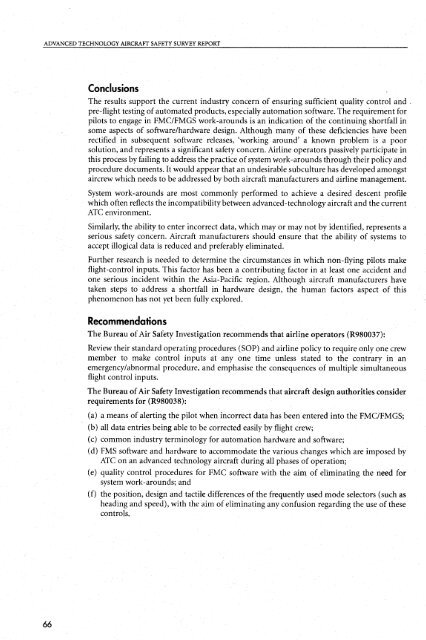Advanced Technology Aircraft Safety Survey Report - Australian ...
Advanced Technology Aircraft Safety Survey Report - Australian ...
Advanced Technology Aircraft Safety Survey Report - Australian ...
Create successful ePaper yourself
Turn your PDF publications into a flip-book with our unique Google optimized e-Paper software.
ADVANCED TECHNOLOGY AIRCRAFT SAFETY SURVEY REPORT<br />
66<br />
Conclusions<br />
The results support the current industry concern of ensuring sufficient quality control and<br />
pre-flight testing of automated products, especially automation software. The requirement for<br />
pilots to engage in FMC/FMGS work-arounds is an indication of the continuing shortfall in<br />
some aspects of software/hardware design. Although many of these deficiencies have been<br />
rectified in subsequent software releases, ‘working around’ a known problem is a poor<br />
solution, and represents a significant safety concern. Airline operators passively participate in<br />
this process by failing to address the practice of system work-arounds through their policy and<br />
procedure documents. It would appear that an undesirable subculture has developed amongst<br />
aircrew which needs to be addressed by both aircraft manufacturers and airline management.<br />
System work-arounds are most commonly performed to achieve a desired descent profile<br />
which often reflects the incompatibility between advanced-technology aircraft and the current<br />
ATC environment.<br />
Similarly, the ability to enter incorrect data, which may or may not by identified, represents a<br />
serious safety concern. <strong>Aircraft</strong> manufacturers should ensure that the ability of systems to<br />
accept illogical data is reduced and preferably eliminated.<br />
Further research is needed to determine the circumstances in which non-flying pilots make<br />
flight-control inputs. This factor has been a contributing factor in at least one accident and<br />
one serious incident within the Asia-Pacific region. Although aircraft manufacturers have<br />
taken steps to address a shortfall in hardware design, the human factors aspect of this<br />
phenomenon has not yet been fully explored.<br />
Recommendations<br />
The Bureau of Air <strong>Safety</strong> Investigation recommends that airline operators (R980037):<br />
Review their standard operating procedures (SOP) and airline policy to require only one crew<br />
member to make control inputs at any one time unless stated to the contrary in an<br />
emergency/abnormal procedure, and emphasise the consequences of multiple simultaneous<br />
flight control inputs.<br />
The Bureau of Air <strong>Safety</strong> Investigation recommends that aircraft design authorities consider<br />
requirements for (R980038):<br />
(a) a means of alerting the pilot when incorrect data has been entered into the FMUFMGS;<br />
(b) all data entries being able to be corrected easily by flight crew;<br />
(c) common industry terminology for automation hardware and software;<br />
(d) FMS software and hardware to accommodate the various changes which are imposed by<br />
ATC on an advanced technology aircraft during all phases of operation;<br />
(e) quality control procedures for FMC software with the aim of eliminating the need for<br />
system work-arounds; and<br />
(f) the position, design and tactile differences of the frequently used mode selectors (such as<br />
heading and speed), with the aim of eliminating any confusion regarding the use of these<br />
controls.
















